
ALL YOU NEED TO KNOW - 2025 AUSTRIAN GRAND PRIX
Table of Contents
Circuit Characteristics and Challen, Key Corners, Racing Considerations, Overtaking Opportunities, Braking Demands, Weather Outlook, Historical Records and Statistics and more...
The Formula 1 paddock reconvenes in the picturesque Styrian Alps for the 2025 Austrian Grand Prix, a familiar fixture returning to its standard format after three years of Sprint Weekend. As the European summer swing intensifies with four races packed into six weeks before the August shutdown, the Red Bull Ring – the high-altitude playground stands ready.
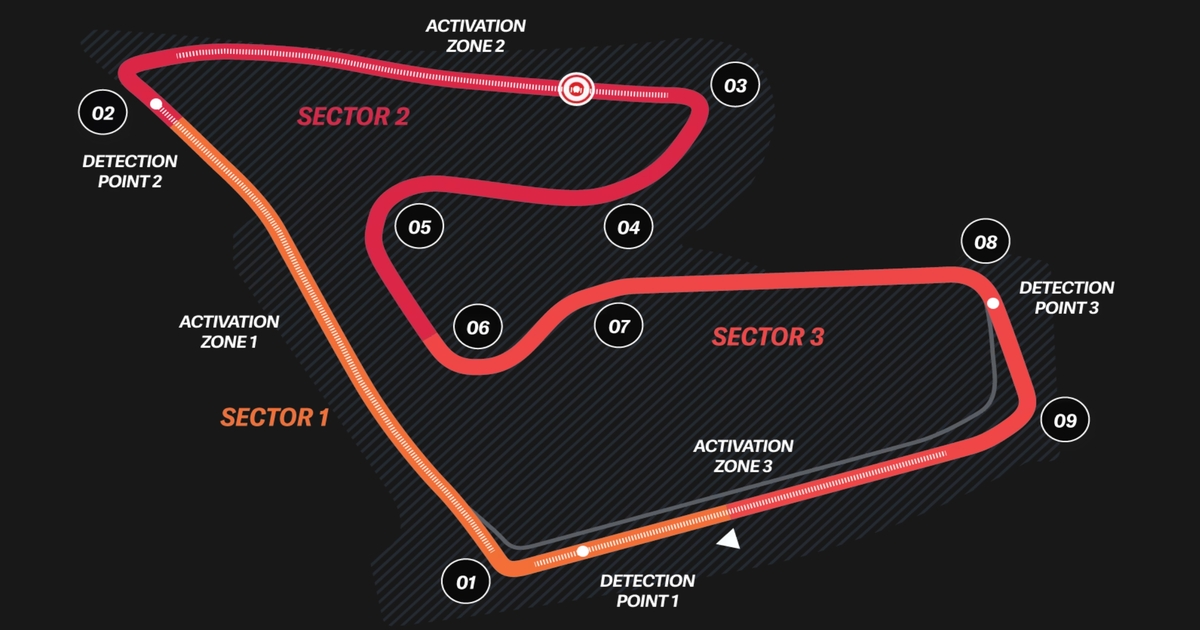
Circuit Characteristics and Challenges
The Red Bull Ring, sculpted from the remnants of the old Österreichring but significantly shortened and modified, is a circuit of distinct personality. Its 4.318 km length, while ranking only fifth shortest on the calendar (behind Monaco, Zandvoort, Mexico City, and Interlagos), has the shortest lap time of the 2025 season. Valtteri Bottas’s outright lap record of 1:02.939, set in 2020, underscores its rapid nature. This is partly due to its configuration boasting just ten classified corners – the fewest of any current F1 track. From an engineering standpoint, Turns 2 (the initial fast right-hander after Turn 1), 5, and 8 are taken at full throttle, making them straights in terms of car dynamics. This places Austria among a select group of four tracks in 2025 (alongside Miami, Canada, and Las Vegas) featuring three such full-throttle "corners."
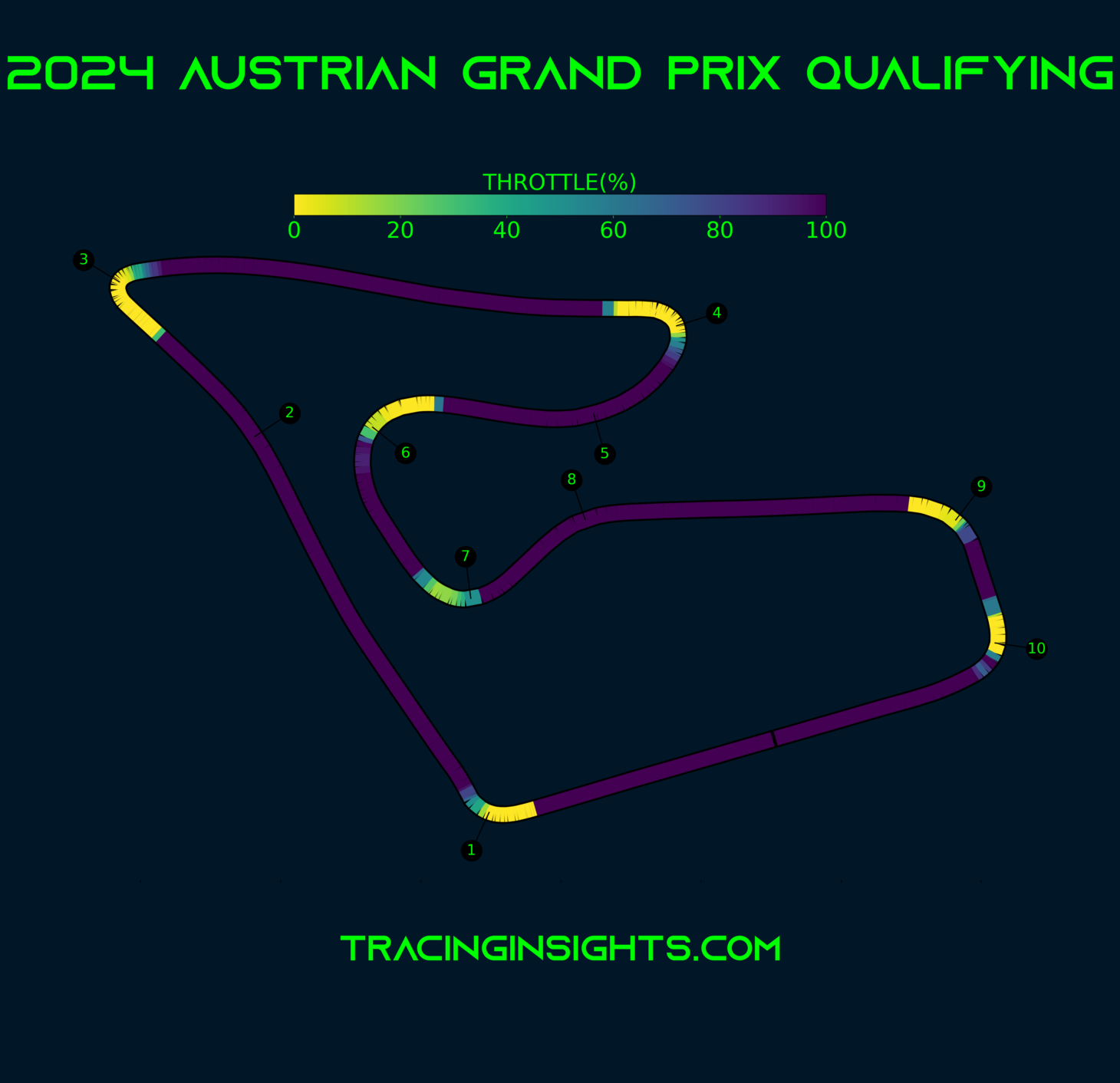
The track is a tale of two distinct, albeit uneven, halves. The track splits into two distinct halves: the first section prioritizes power and low aerodynamic drag across 3 DRS-enabled straights, while the second half sends the cars tumbling back downhill through a sequence of quick corners where high downforce is rewarded. This dichotomy presents a fundamental setup challenge for engineers: optimize for straight-line speed or cornering grip, a compromise that often sees teams playing to their car's inherent strengths. The need for ample power and traction is constant.
One of the circuit's defining features is its dramatic topography. The elevation change between its lowest and highest points is a significant 63.5 metres, placing it second only to Spa-Francorchamps in this regard and unsurprising given its location in the Styrian mountains. Steep gradients exist not only longitudinally but also from track edge-to-edge in places, exemplified by Turns 3 and 4 where the circuit slopes upwards towards the apex as cars crest a rise. This can unweight, or even lift, an inside wheel, complicating braking, stability, and traction on corner exit. The run from a standing start to the Turn 1 braking point is a relatively short 233 meters.
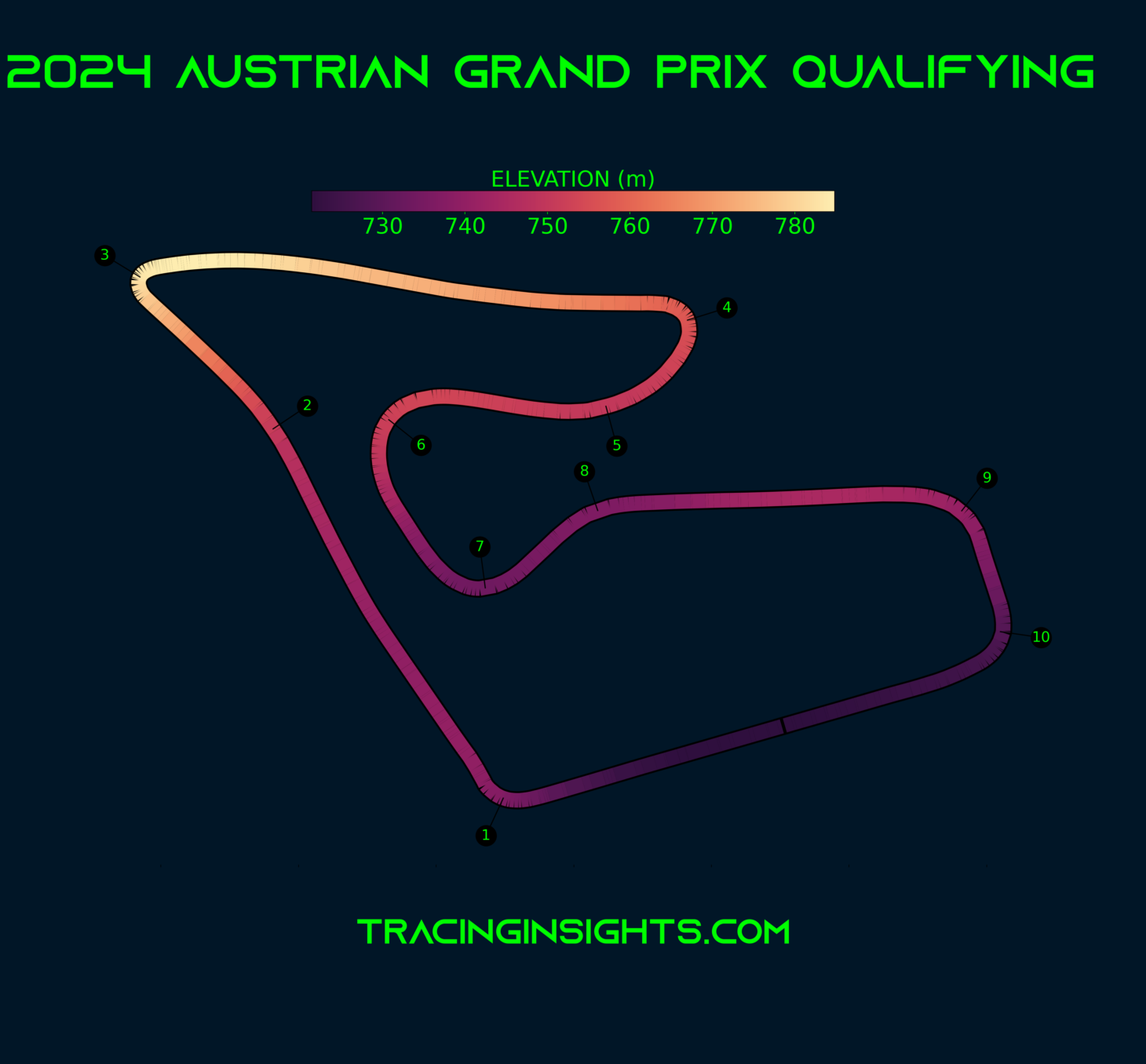
Demands on car handling are comprehensive, requiring excellent mechanical grip at low speeds for the likes of Turns 1, 3, and 4, concurrently with strong aerodynamic performance for the high-speed sweeps of Turns 6-7 and 9-10. Suspension systems face a stern examination from Spielberg’s notoriously aggressive kerbs. These are particularly punishing at the exits of Turn 1, Turn 6, and Turn 7, where their amplitude and the frequency at which they are encountered take a high toll on the cars. Drivers note the need for caution, as riding these abrasive kerbs can easily inflict suspension damage.
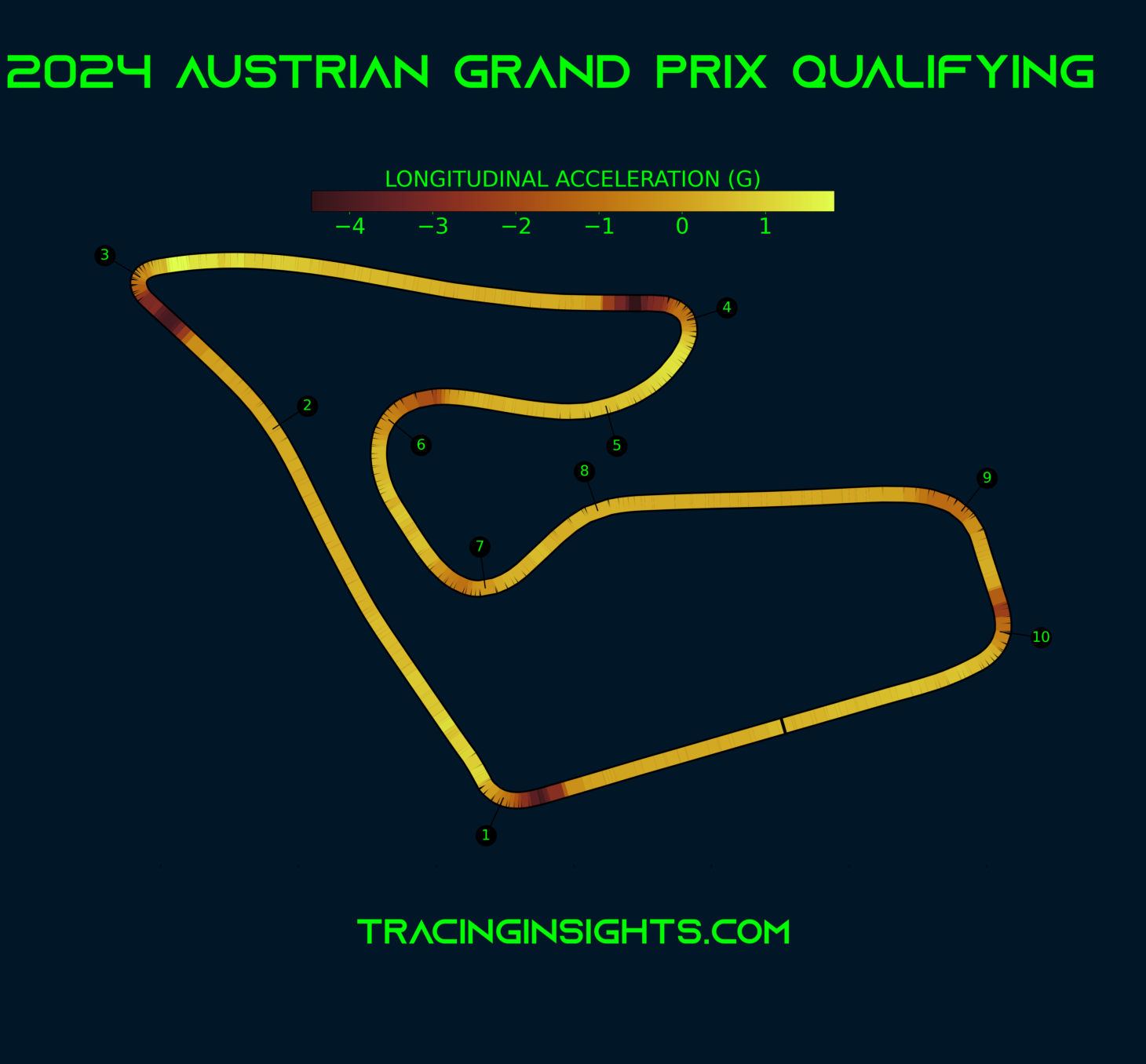
The track surface itself is rather old and highly abrasive, yet tyre wear is not typically a key limiting factor due to the relatively few high-energy lateral load corners. The venue sees considerable use from both four-wheeled and two-wheeled categories, meaning the track surface tends to be well rubbered-in from the start of the race weekend. Despite its short length, the circuit presents hidden technicalities. It’s often described as short, sharp, and shockingly rapid.
Pit Lane and Technical Features
For the 2025 event, the pit lane itself has undergone resurfacing. The time lost during a standard pit stop, including the stationary time of ~2.5 seconds, is about 20.3 seconds.
A noteworthy technical aspect off-track is the circuit’s pioneering role in sustainability. The 2023 Austrian Grand Prix marked Formula 1's first deployment of its low-carbon energy solution for the paddock. This initiative involved a combination of hydrotreated vegetable oil (HVO), solar panels, and battery energy storage systems (BESS), removing the need for the ten F1 teams, the FIA, and F1's own operations to rely on their individual generators.
Key Corners
-
Turn 1: The steep climb to the first corner, though not as extended as on the old Österreichring, is a significant feature. It's a right-hander that drivers often feel is quicker than anticipated, setting the tone for a braking-intensive first sector.
-
Turn 2: After Turn 1 peels off to the right, what is designated Turn 2 is a full-throttle right-hand kink leading onto a straight section that connects to the old track.
-
Turn 3: This abrupt, tight right-hand hairpin marks the end of a straight and involves a steep climb. It is one of the most demanding corners for the braking system. The approach features an uphill braking point, and the corner itself is notoriously tricky due to camber changes; the track slopes up towards the apex as cars negotiate a crest, often causing at least one wheel to lift if the driver aggressively targets the apex. This complicates braking, stability, and traction.
-
Turn 4: A downhill braking zone into another right-hander, Turn 4 is cited by drivers as one of the easiest places to make an error, with many finding the gravel on exit. It is also a critical point for the braking system.

-
Turn 5 & Turn 6: The sweeping Turn 5 leads into the arc of Turn 6, initiating the transition into the faster, flowing second half of the lap. The exit kerbs of Turn 6 are a known suspension punisher and a critical track limits hotspot.
-
Turn 7: From the exit of Turn 7, the track begins another slight climb.
-
Turn 8: Another full-throttle "corner."
-
Turns 9 & 10: The final sector is dominated by this double right-hander. The original double apex final corner was reprofiled into more of a dogleg to allow for a decent run-off area on the outside. Braking for Turn 10 offers a late overtaking chance. Track limits, particularly at these two corners, were a major issue in 2023, though modifications have since helped.
Racing Considerations
Track limits have historically been a significant talking point at the Red Bull Ring. The 2023 race saw an extraordinary 1,200 potential infringements reviewed by the FIA. Subsequent changes, including reducing the usable kerb area with painted lines and adding gravel strips as natural deterrents, particularly at Turns 9 and 10, largely eradicated the problem. However, vigilance is still required. Turn 6, for instance, saw Oscar lose his final Q3 lap and third place on the 2024 grid for an infringement, with Yuki Tsunoda, Pierre Gasly, and Charles Leclerc also having laps deleted there during qualifying.
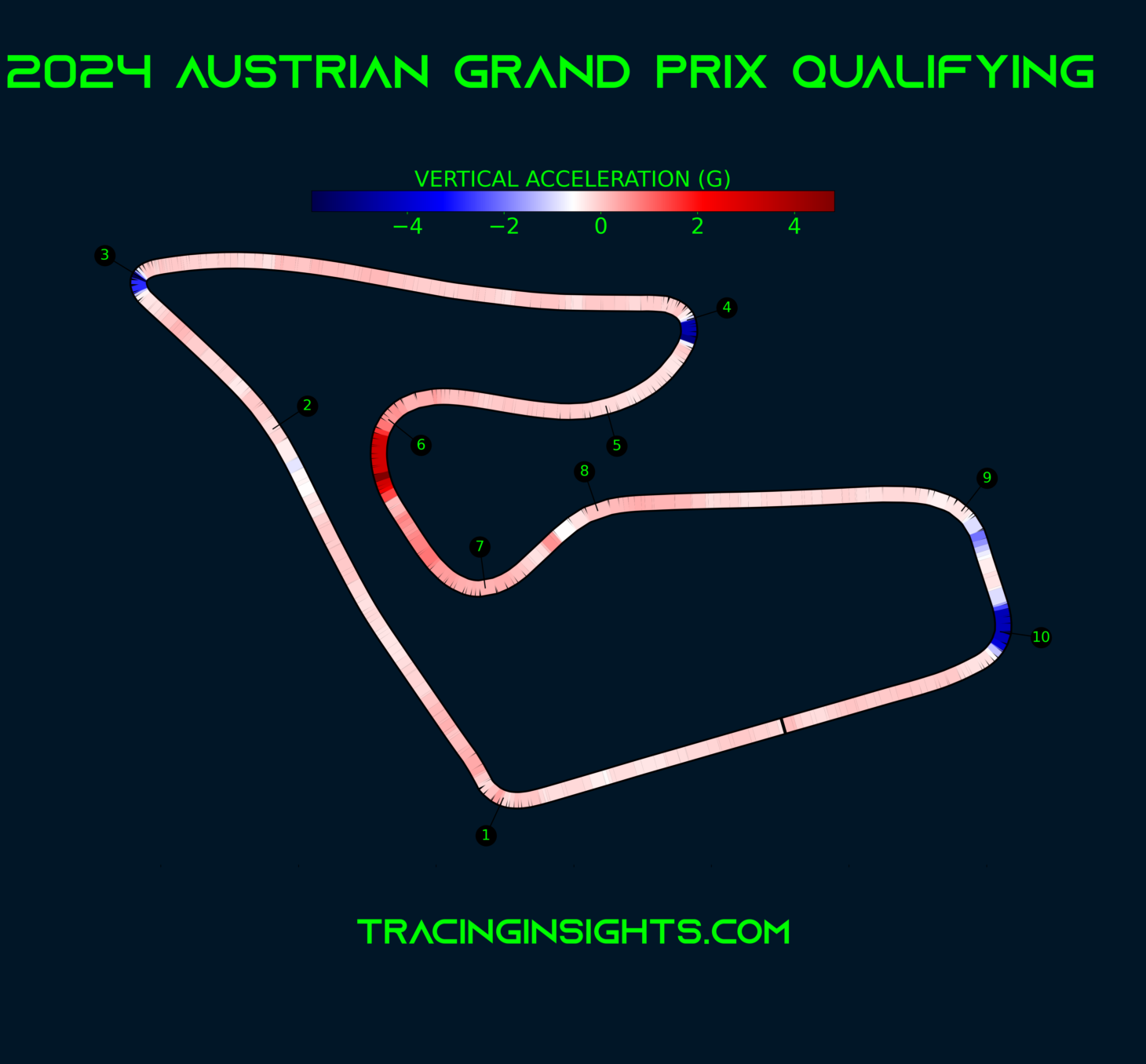
The probability of a Safety Car intervention during the race is statistically rated at 38%, while the chance of a Virtual Safety Car period is higher at 50%. In 2024, a total of 85 overtakes were completed during the Grand Prix. The circuit’s design, despite being constrained by the small parcel of land it occupies, has not hampered the racing quality; it consistently produces high-speed, overtaking-friendly contests filled with drama.
Overtaking Opportunities
With three DRS zones, the Red Bull Ring is renowned for fostering action-packed racing.
-
The first DRS zone is on the run up to Turn 1.
-
The primary overtaking spots are generally considered to be Turn 1, Turn 3, and Turn 4, all located in the power-dependent first half of the lap. Cars can get close on the three straights and engage in battles through this sequence.
-
The long climb up to Turn 3, aided by DRS, makes it a prime location. However, a well-defended inside line can make passing tricky, though defending here can leave a car vulnerable on the subsequent downhill DRS run to Turn 4.
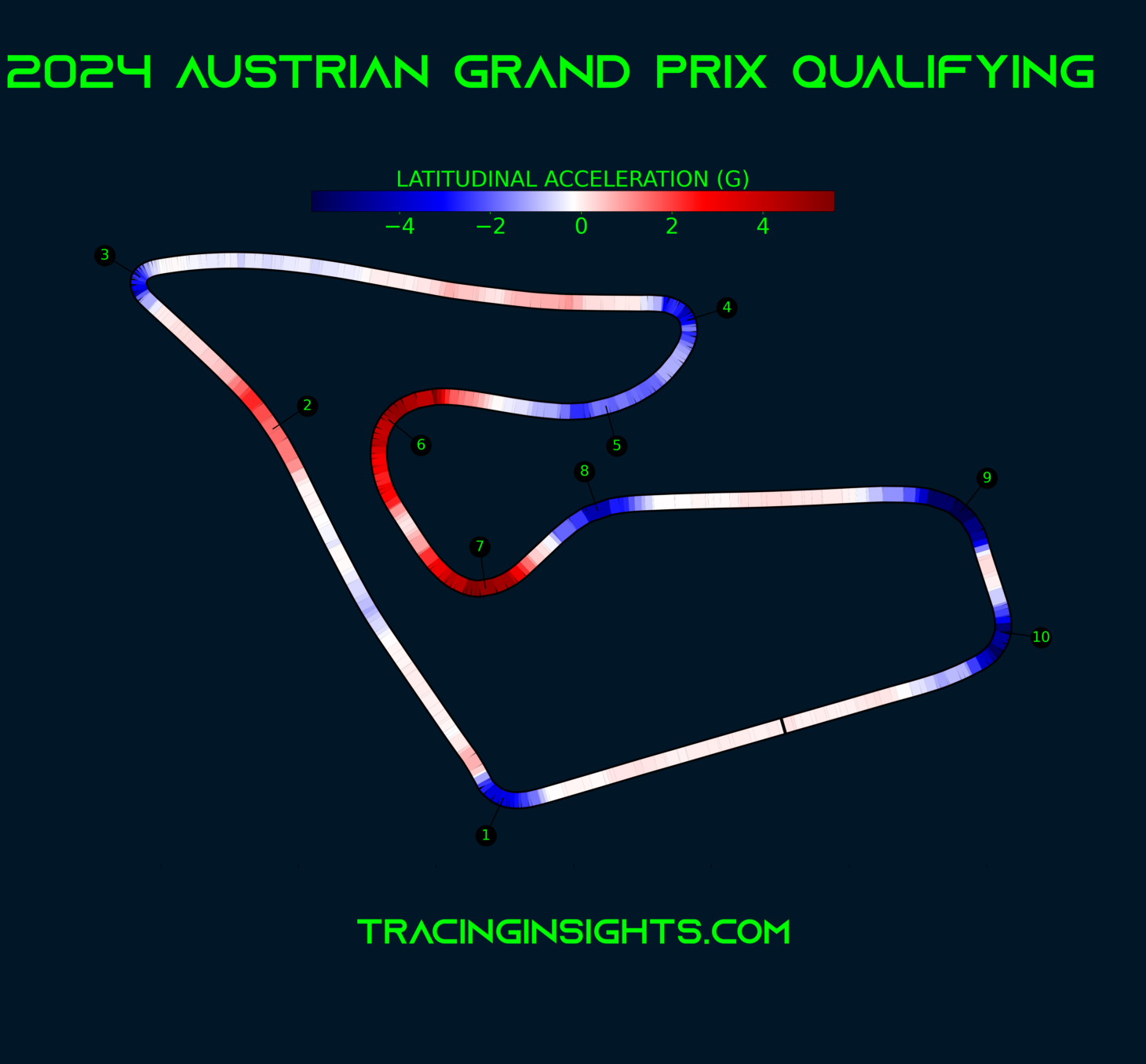
-
A degree of "DRS chess" often unfolds: a pass made into Turn 1 carries a strong likelihood of being re-passed into Turn 3, leading some drivers to hold fire. The patient tactician may wait until Turn 4 to make a decisive move, then utilize the faster corners of the second half of the lap to break the tow.
-
A final overtaking opportunity exists under braking into the downhill Turn 10, though the last DRS zone is positioned immediately after this corner on the start-finish straight.
Braking Demands
The Spielberg circuit is exceptionally demanding on braking systems. Characterized by hilly terrain and sharp bends, it features six significant deceleration braking sections. The short lap distance offers minimal recovery time for the brakes to cool between these heavy applications. This relentless duty cycle leads to high operating temperatures for brake materials, affecting maximum brake pressures and accelerating wear and tear. So, teams are forced to run significant cooling levels for the brakes.
F1 BREMBO BRAKING DATA – AUSTRIAN GP 2025
| Turn | Initial Speed (km/h) | Final Speed (km/h) | Stopping Distance (m) | Braking Time (sec) | Max Deceleration (g) | Max Pedal Load (kg) | Braking Power (kW) |
|---|---|---|---|---|---|---|---|
| ≡ 01 | 302 | 132 | 93 | 1.67 | 4.6 | 141 | 2,356 |
| ≡ 03 | 306 | 78 | 112 | 2.58 | 4.6 | 142 | 2,355 |
| ≡ 04 | 319 | 112 | 115 | 2.28 | 4.4 | 141 | 2,388 |
| = 06 | 273 | 219 | 52 | 0.76 | 3.0 | 70 | 1,144 |
| _ 08 | 305 | 279 | 31 | 0.38 | 2.8 | 55 | 1,006 |
| = 09 | 267 | 199 | 59 | 0.94 | 3.4 | 97 | 1,444 |
The approaches to Turn 1, Turn 3, and Turn 4 are considered the three most demanding braking zones, occurring in relatively quick succession. Turn 3's uphill braking point adds to its severity. The challenge of keeping brakes within their optimal temperature window without overcooling can, conversely, make it difficult to bring the front tyres up to their ideal operating temperature, especially during a short qualifying out-lap.
Tyre Selection and Strategy
Pirelli will supply the C3 (Hard), C4 (Medium), and C5 (Soft) compounds for the 2025 Austrian Grand Prix, the same selection as in the previous year. While the track surface is old and abrasive, the limited number of high-energy lateral corners means that macroscopic tyre wear is not usually the dominant concern. Instead, thermal degradation is the primary factor influencing tyre life and performance, particularly for the rear axle. This is driven by the repeated hard braking and acceleration phases inherent in the track layout. Managing tyre overheating is a significant challenge, especially as air and track temperatures can be very high at this time of year; a peak track temperature of 55.1 degrees Celsius has been recorded previously, potentially making Spielberg the hottest surface of the season.
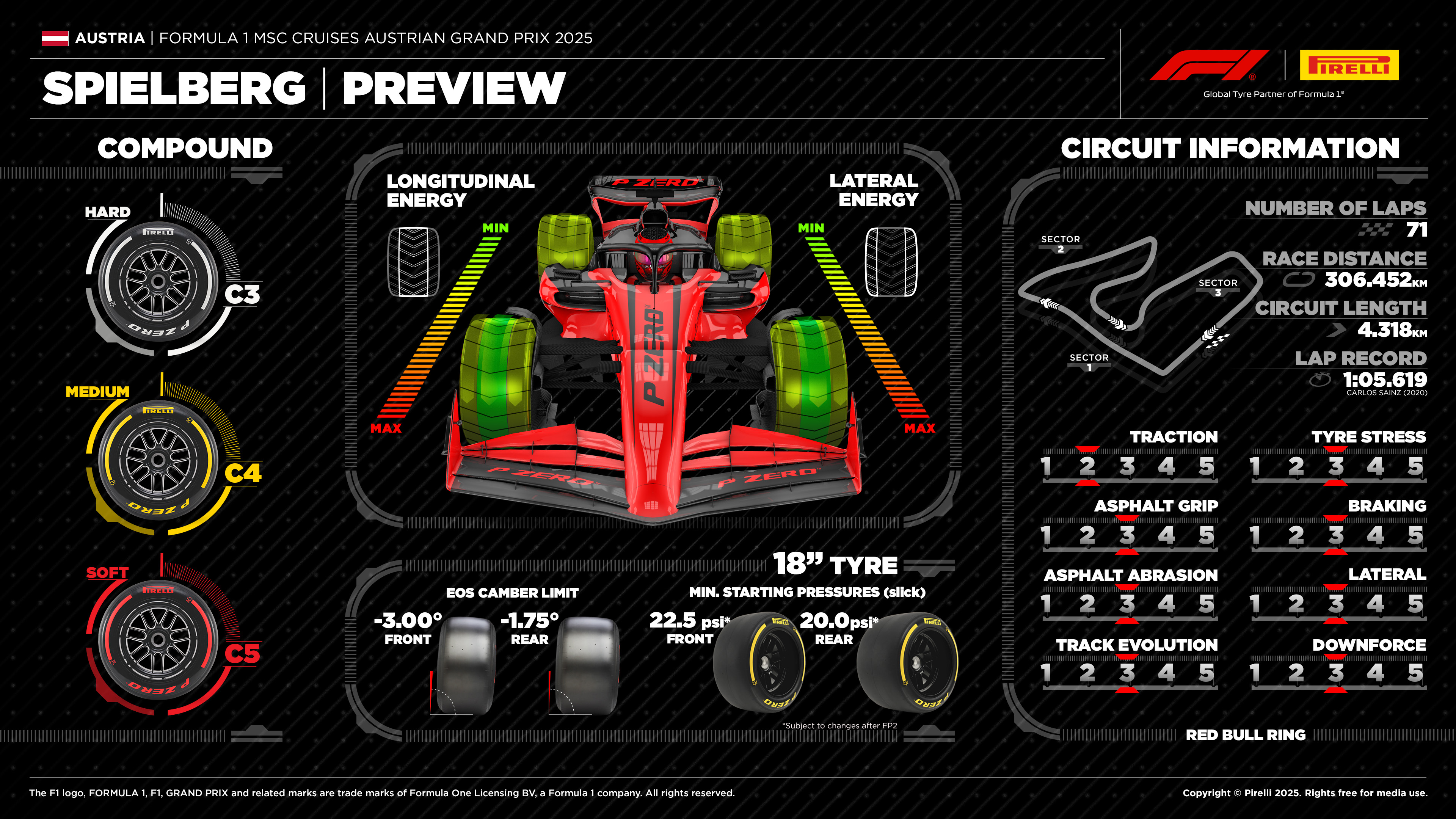
A specific tyre phenomenon teams monitor is "porosity." Intense mechanical and thermal stress causes the tyre to deform, especially under acceleration and braking and on rougher surfaces. This builds up energy and heat within the compound. If temperatures exceed the optimal operating window, microcavities and surface irregularities can form. This surface porosity can lead to premature degradation. These microcavities can also facilitate the formation and expansion of gas or vapour bubbles aka blisters, between the tyre carcass and the tread. Excessive heat can cause partial separation of the rubber layers, and these bubbles can evolve into craters or holes on the tread surface. This "blistering," often visible as dark streaks or damaged areas on the tread, is more common on a track that is not heavily rubbered-in, features high surface temperatures, or when subjected to a very aggressive driving style.
The return to a standard weekend format for 2025, without a Sprint race, means teams will approach their Sunday tyre allocation differently. There won't be as many Medium tyres naturally filtering into the race allocation, making the decision of whether to retain two sets of Mediums or two sets of Hards for the Grand Prix a trickier strategic call. With the same tyre compounds available as in 2024, a dry race is likely to produce similar strategic patterns, with two-stop strategies expected to be the norm.
Last Year's Strategic Picture (2024)
The 2024 Austrian Grand Prix was very linear, at least for the first two-thirds. A two-stop strategy proved to be the most effective. Drivers who made three or more stops – including Max Verstappen, Charles Leclerc, Fernando Alonso, and Logan Sargeant – did so due to unforeseen circumstances rather than by strategic design.
All drivers on the grid started on the Medium (C4) tyres, with the exception of Guanyu Zhou, who started from the pit lane on the Hard (C3) compound. The C4 Medium and C3 Hard were the undisputed protagonists of the race. The C5 Soft tyre saw very limited use, appearing only towards the end: Verstappen fitted them for the last seven laps after a forced stop due to puncture, and Alonso used them for a successful fastest lap attempt on lap 68 of 70.
Daniel Ricciardo completed the longest single stint of the race, running 34 laps on the Hard tyre during his third and final stint. On the Mediums, Pierre Gasly achieved the longest stint, covering 29 laps, also in his final stint.
The battle for the win saw Max Verstappen initially on course for victory with a Medium-Hard-Medium strategy. However, a slow pit stop dropped him into a battle with Lando Norris, and a subsequent collision between them allowed George Russell, who was running a Medium-Medium-Hard strategy (similar to Alonso), to take the win.
Looking back further, Max Verstappen had a cleaner 2023 event, executing a Medium-Hard-Medium strategy from pole position to victory. The 2022 race, won by Charles Leclerc with Verstappen second, saw both front-runners pit under a late Virtual Safety Car for a final set of Mediums, deviating from what might have otherwise been a C4-C3-C3 race. The last three editions of the Austrian Grand Prix have all been won on two-stop strategies.
Weather Outlook and Its Impact
The Red Bull Ring's location in the foothills of the Styrian mountains, surrounded by forests, often leads to a 'microclimate' effect, similar to that experienced at Spa-Francorchamps. While early summer can bring high ambient temperatures – with the current 2025 forecast predicting 30°C+ conditions which could necessitate the use of additional cooling kits on the cars – the weather can change with notorious rapidity.
Storm clouds can build quickly, potentially leading to torrential rain. A stark example of this volatility was Saturday at the 2020 Styrian Grand Prix, where FP3 was cancelled due to heavy rain and qualifying was significantly disrupted by downpours. Although the initial forecast for the 2025 race weekend suggests no rain, this can swiftly change. Unpredictable weather directly impacts grip levels and keeps strategy teams on high alert.
Teams must balance cooling requirements against performance optimization, with temperature management becoming a key differentiator.
Historical Records and Statistics
The 2025 race marks the 38th running of the World Championship Austrian Grand Prix and Formula 1's 40th appearance in the Styria region.
-
First Race: 1964, held on a temporary circuit at Zeltweg Airfield, a stone's throw from the current venue.
-
Österreichring Era: The race moved to the newly constructed, fearsome Österreichring in Spielberg in 1970 and was a calendar staple until 1987.
-
A1-Ring Era: After a ten-year break, the event returned from 1997 to 2003 on a shortened and modified version of the track, renamed the A1-Ring.
-
Red Bull Ring Era: The Grand Prix made its comeback in 2014 with the circuit now called the Red Bull Ring, though the track layout remains functionally unchanged from the A1-Ring configuration. Fernando Alonso is the only driver on the current grid to have raced at the circuit before it was renamed the Red Bull Ring.
-
Styrian Grands Prix: In 2020 and 2021, as part of Covid-19 pandemic-adjusted calendars, the Red Bull Ring uniquely hosted consecutive races, staging the Styrian Grand Prix back-to-back with the Austrian Grand Prix. It was the first circuit to host such consecutive events.
-
Lap Records:
-
Outright/Qualifying Lap Record: 1:02.939, set by Valtteri Bottas (Mercedes) during Q3 in 2020. (Bottas also holds the record for the all-time shortest F1 lap time of 0:53.377, set on the Outer Circuit of the Bahrain International Circuit during the 2020 Sakhir Grand Prix).
-
Race Lap Record: 1:05.619, set by Carlos Sainz (McLaren) in 2020.
-
-
Driver Success:
-
Most Wins at the Circuit (Austrian & Styrian GPs combined): Max Verstappen, with five victories (four Austrian GPs, one Styrian GP in 2021). From 12 outings at the Red Bull Ring, Verstappen has won 42% of the races he’s contested there and featured on the podium 66.6% of the time.
-
Most Pole Positions at the Circuit: Max Verstappen, with five (four Austrian GP poles, one Styrian GP pole).
-
Most Podiums at the Circuit: Max Verstappen, with eight.
-
Niki Lauda is the only Austrian driver to have won the Austrian Grand Prix, achieving this feat in 1984.
-
George Russell's 2024 triumph made him a winner at the Red Bull Ring at Formula 1, Formula 2, and Formula 3 levels.
-
26 different drivers have won at least once in Austria (counting all F1 races held there). Eleven of these are World Champions: Verstappen, Alain Prost, Alan Jones, Mika Hakkinen, Michael Schumacher, Nico Rosberg, Emerson Fittipaldi, Niki Lauda, Nigel Mansell, Jacques Villeneuve, and Lewis Hamilton.
-
Several Austrian drivers, or those racing under an Austrian licence, have made their F1 debuts in Austria, including World Champions Jochen Rindt (1964) and Niki Lauda (1971), as well as Helmut Marko (1971) and Gerhard Berger (1984).
-
-
Constructor Success:
-
Most Wins at the Circuit (Austrian & Styrian GPs combined): Mercedes, with a total of seven victories. Lewis Hamilton's win in the 2020 Styrian Grand Prix tips the balance in their favour.
-
Most Austrian Grand Prix Wins: Mercedes, Ferrari, and McLaren are tied with six wins each in the eponymous Austrian Grand Prix.
-
Most Pole Positions (Austrian GP): Ferrari leads with eight.
-
Most Podium Finishes (Austrian GP): Ferrari holds the record with 29.
-
2025 Austrian Grand Prix – Stat Sheet
TRACK CHARACTERISTICS
TRACTION
2/5
TYRE STRESS
3/5
ASPHALT GRIP
3/5
BRAKING
3/5
ASPHALT ABRASION
3/5
LATERAL
3/5
TRACK EVOLUTION
3/5
DOWNFORCE
3/5
Circuit Characteristics
| Characteristic | Value |
|---|---|
| Circuit Length | 4.318 km |
| Race Laps | 71 |
| Race Distance | 306 km |
| Number of Corners | 10 (3 L / 7 R) |
| Distance from Pole to First Braking Zone | 214 m |
| Pole Position Side | Left |
| Pit Lane Length Under Speed Limit Control | 359 m |
| Drive-Through Time at 80 km/h | 16s |
| Lap Time At Full Throttle | 66% |
| Lap Distance At Full Throttle | 73% |
| Gear Changes Per Lap | 40 |
| Braking Events (>2G) | 6 |
| Heavy Braking Events (<0.4s @ >4G) | 3 |
| Braking Energy | Low |
| Maximum Lateral G-Force | 4.2 (T9) |
| Maximum Speed | 318.3 km/h |
| Fuel Consumption | Low |
| DRS Zones | T1–2, T3–4, T10–1 |
| Key Overtaking Opportunities | T3, T4 |
2024 Statistics
| Statistic | Value |
|---|---|
| Fastest Lap FP1 | 1:05.685 |
| Fastest Lap Sprint Qualifying | 1:04.686 |
| Fastest Lap Sprint Race | 1:08.935 |
| Fastest Lap Q1 | 1:05.263 |
| Fastest Lap Q2 | 1:04.469 |
| Fastest Lap Q3 | 1:04.314 |
| Delta FP1 to Q3 | -1.371s |
| Delta Q1 to Q3 | -0.949s |
| Podium | RUS / PIA / SAI |
| Team Result | P1 RUS / P4 HAM |
| Fastest Race Lap | 1:07.694 (ALO) |
| Winning Race Time | 1:24:22.798 |
| Winning Average Speed | 217.908 km/h |
| Qualifying Speed Trap | 321.4 km/h (BOT) |
| Race Speed Trap | 325.6 km/h (HUL) |
| Winning Strategy | 2 Stop (L22 / L46) |
| Total Pit Stops | 45 |
| Total Normal Overtakes | 9 |
| Total DRS Overtakes | 34 |
| Race Lap Record | 1:05.619 (SAI, 2020) |
| Absolute Lap Record | 1:02.939 (BOT, Q3, 2020) |
| Not Classified (Accident/DSQ) | 0 |
| Not Classified (Mechanical) | 0 |
Race Characteristics (2020–2024)
| Characteristic | Value |
|---|---|
| Races Featuring Safety Car | 3/5 |
| Total Safety Car Deployments | 3 |
| Safety Car Probability | 60% |
| Safety Car Ratio | 0.6 |
| Wet Sessions | 3/25 |
| Wet Session Probability | 12% |
| Average Track Temperature | 41.5°C |
| Maximum Track Temperature | 53.2°C |
| Average Ambient Temperature | 26°C |
| Maximum Ambient Temperature | 34°C |
| Ambient Pressure | 935.6 hPa |
Where to Watch 2025 Spanish Grand Prix
I’m constantly changing things up to make this newsletter more useful, so let me know what you think by commenting below. I read every reply! Please do reply. I'm not a robot, I talk back.
Follow me on Whatsapp, Telegram, Facebook, YouTube, LinkedIn, Pixelfed, Tumblr, Bsky, Twitter, Mastodon, Instagram, Sub-Reddit, Threads for more analysis!